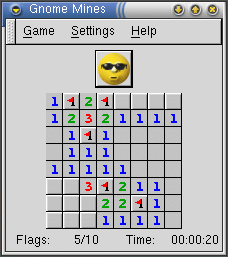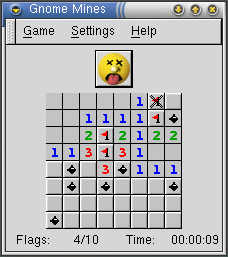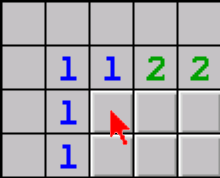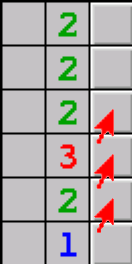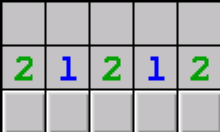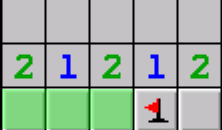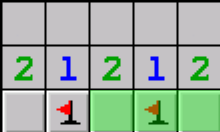Usage
This section describes how to use this application.
Basic usage
Starting GNOME Mines opens the Main window, shown in Figure 1.
The bottom of the window shows a game timer on the right and a counter on the left showing how many flags have been placed and how many mines exist.
Play proceeds by uncovering squares with the left mouse button and placing flags with the right mouse button. Successfully uncovered squares yield information: the number of mines in the adjacent squares. Figure Figure 2 shows a game in play. Note the numbers in the cleared squares and their relation to flags.
Using the information gathered from the uncovered squares the player forms hypotheses about the location of undiscovered mines.
As flags are added the middle mouse button may be used on the previously uncovered squares. If the number of flags adjacent to that square satisfies the number expected the middle mouse button will automatically uncover all remaining adjacent squares. If a flag has been placed by mistake this action will uncover a mine and end play. Figure Figure 3 shows the result of just such a mistake, note the flag in the top row.
If flags have been correctly placed on all the mines, and the remaining squares have been uncovered the game is won, as shown in Figure 4.
Basic Strategy
The geometrical arrangement of uncovered and flagged squares often limits the possible locations that can contain hidden mines. Figure Figure 5 shows how the location of a mine, pointed to by the arrow, has been inferred using the square on the outside corner showing the numeral one. The geometry of the corner has left only one uncovered square next to the one.
The same strategy has been used in figure Figure 6 where the square showing the number three has only three remaining uncovered squares that can hold mines. to
In the previous cases we found the location of mines using the information from a single uncovered square. More advanced play comes from combining information from two or more uncovered squares. Consider the arrangement of squares in figure Figure 7.
If we focus on the leftmost square showing "1" we know that only a single flag can be contained in the three uncovered squares highlighted in green in figure Figure 8, thus we can infer where the second flag for the square showing "2" must be placed.
We can now repeat the same process with the rightmost square showing "1" to place the second flag, see Figure Figure 9.

